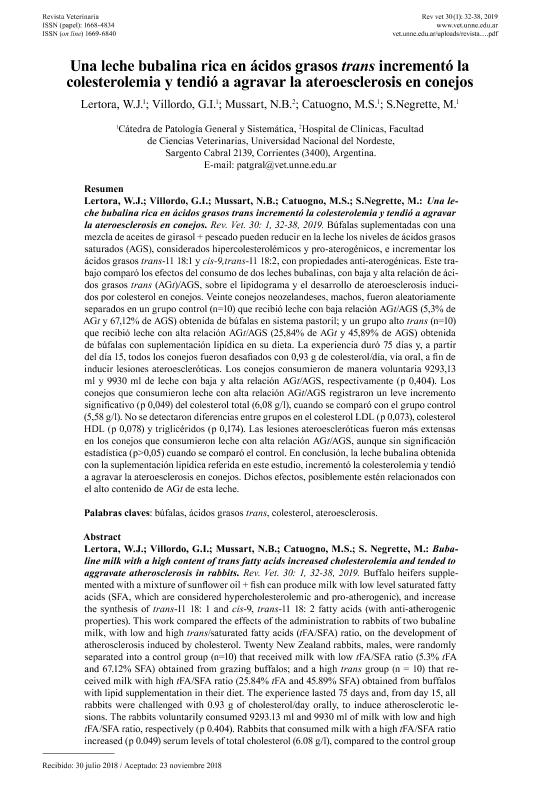Mostrar el registro sencillo del ítem
dc.contributor.author
Lertora, Walter Javier

dc.contributor.author
Villordo, Gabriela Ines

dc.contributor.author
Mussart, Norma Beatriz

dc.contributor.author
Catuogno, María Silvia

dc.contributor.author
Sanchez Negrette, Marcial

dc.date.available
2020-12-03T15:20:09Z
dc.date.issued
2019-07
dc.identifier.citation
Lertora, Walter Javier; Villordo, Gabriela Ines; Mussart, Norma Beatriz; Catuogno, María Silvia; Sanchez Negrette, Marcial; Una leche bubalina rica en ácidos grasos trans incrementó la colesterolemia y tendió a agravar la ateroesclerosis en conejos; Universidad Nacional del Nordeste. Facultad de Ciencias Veterinarias; Veterinaria; 30; 1; 7-2019; 32-38
dc.identifier.issn
1668-4834
dc.identifier.uri
http://hdl.handle.net/11336/119723
dc.description.abstract
Búfalas suplementadas con una mezcla de aceites de girasol + pescado pueden reducir en la leche los niveles de ácidos grasos saturados (AGS), considerados hipercolesterolémicos y pro-aterogénicos, e incrementar los ácidos grasos trans-11 18:1 y cis-9,trans-11 18:2, con propiedades anti-aterogénicas. Este trabajo comparó los efectos del consumo de dos leches bubalinas, con baja y alta relación de ácidos grasos trans (AGt)/AGS, sobre el lipidograma y el desarrollo de ateroesclerosis inducidos por colesterol en conejos. Veinte conejos neozelandeses, machos, fueron aleatoriamente separados en un grupo control (n=10) que recibió leche con baja relación AGt/AGS (5,3% de AGt y 67,12% de AGS) obtenida de búfalas en sistema pastoril; y un grupo alto trans (n=10) que recibió leche con alta relación AGt/AGS (25,84% de AGt y 45,89% de AGS) obtenida de búfalas con suplementación lipídica en su dieta. La experiencia duró 75 días y, a partir del día 15, todos los conejos fueron desafiados con 0,93 g de colesterol/día, vía oral, a fin de inducir lesiones ateroescleróticas. Los conejos consumieron de manera voluntaria 9293,13 ml y 9930 ml de leche con baja y alta relación AGt/AGS, respectivamente (p 0,404). Los conejos que consumieron leche con alta relación AGt/AGS registraron un leve incremento significativo (p 0,049) del colesterol total (6,08 g/l), cuando se comparó con el grupo control (5,58 g/l). No se detectaron diferencias entre grupos en el colesterol LDL (p 0,073), colesterol HDL (p 0,078) y triglicéridos (p 0,174). Las lesiones ateroescleróticas fueron más extensas en los conejos que consumieron leche con alta relación AGt/AGS, aunque sin significación estadística (p>0,05) cuando se comparó el control. En conclusión, la leche bubalina obtenida con la suplementación lipídica referida en este estudio, incrementó la colesterolemia y tendió a agravar la ateroesclerosis en conejos. Dichos efectos, posiblemente estén relacionados con el alto contenido de AGt de esta leche.
dc.description.abstract
Bubaline milk with a high content of trans fatty acids increased cholesterolemia and tended to aggravate atherosclerosis in rabbits. Rev. Vet. 30: 1, 32-38, 2019. Buffalo heifers supplemented with a mixture of sunflower oil + fish can produce milk with low level saturated fatty acids (SFA, which are considered hypercholesterolemic and pro-atherogenic), and increase the synthesis of trans-11 18: 1 and cis-9, trans-11 18: 2 fatty acids (with anti-atherogenic properties). This work compared the effects of the administration to rabbits of two bubaline milk, with low and high trans/saturated fatty acids (tFA/SFA) ratio, on the development of atherosclerosis induced by cholesterol. Twenty New Zealand rabbits, males, were randomly separated into a control group (n=10) that received milk with low tFA/SFA ratio (5.3% tFA and 67.12% SFA) obtained from grazing buffalos; and a high trans group (n = 10) that received milk with high tFA/SFA ratio (25.84% tFA and 45.89% SFA) obtained from buffalos with lipid supplementation in their diet. The experience lasted 75 days and, from day 15, all rabbits were challenged with 0.93 g of cholesterol/day orally, to induce atherosclerotic lesions. The rabbits voluntarily consumed 9293.13 ml and 9930 ml of milk with low and high tFA/SFA ratio, respectively (p 0.404). Rabbits that consumed milk with a high tFA/SFA ratio increased (p 0.049) serum levels of total cholesterol (6.08 g/l), compared to the control group (5.58 g/l). No differences were detected between groups in LDL cholesterol (p 0.073), HDL cholesterol (p 0.078) and triglycerides (p 0.174). Atherosclerotic lesions were more extensive in rabbits that consumed milk with a high tFA/SFA ratio, although without statistical significance (p> 0.05) compared to rabbits that consumed milk with low tFA/SFA ratio. In conclusion, bubaline milk obtained from animals with lipid supplementation contributed to increase cholesterolemia and tended to worsen atherosclerosis in rabbits. These effects may be related to the high content of tFA of this milk.
dc.format
application/pdf
dc.language.iso
spa
dc.publisher
Universidad Nacional del Nordeste. Facultad de Ciencias Veterinarias

dc.rights
info:eu-repo/semantics/openAccess
dc.rights.uri
https://creativecommons.org/licenses/by-nc-sa/2.5/ar/
dc.subject
ATHEROSCLEROSIS
dc.subject
BUFFALOS
dc.subject
CHOLESTEROL
dc.subject
TRANS FATTY ACIDS
dc.subject.classification
Ciencias Veterinarias

dc.subject.classification
Ciencias Veterinarias

dc.subject.classification
CIENCIAS AGRÍCOLAS

dc.title
Una leche bubalina rica en ácidos grasos trans incrementó la colesterolemia y tendió a agravar la ateroesclerosis en conejos
dc.title
Bubaline milk with a high content of trans fatty acids increased cholesterolemia and tended to aggravate atherosclerosis in rabbits
dc.type
info:eu-repo/semantics/article
dc.type
info:ar-repo/semantics/artículo
dc.type
info:eu-repo/semantics/publishedVersion
dc.date.updated
2020-11-18T17:06:01Z
dc.identifier.eissn
1669-6840
dc.journal.volume
30
dc.journal.number
1
dc.journal.pagination
32-38
dc.journal.pais
Argentina

dc.journal.ciudad
Corrientes
dc.description.fil
Fil: Lertora, Walter Javier. Universidad Nacional del Nordeste. Facultad de Ciencias Veterinarias; Argentina
dc.description.fil
Fil: Villordo, Gabriela Ines. Universidad Nacional del Nordeste. Facultad de Ciencias Veterinarias; Argentina
dc.description.fil
Fil: Mussart, Norma Beatriz. Universidad Nacional del Nordeste. Facultad de Cs.veterinarias. Departamento de Clinica; Argentina. Consejo Nacional de Investigaciones Científicas y Técnicas. Centro Científico Tecnológico Conicet - Nordeste; Argentina
dc.description.fil
Fil: Catuogno, María Silvia. Consejo Nacional de Investigaciones Científicas y Técnicas. Centro Científico Tecnológico Conicet - Nordeste; Argentina. Universidad Nacional del Nordeste. Facultad de Ciencias Veterinarias; Argentina
dc.description.fil
Fil: Sanchez Negrette, Marcial. Universidad Nacional del Nordeste. Facultad de Ciencias Veterinarias; Argentina
dc.journal.title
Veterinaria

dc.relation.alternativeid
info:eu-repo/semantics/altIdentifier/doi/http://dx.doi.org/10.30972/vet.3013895
dc.relation.alternativeid
info:eu-repo/semantics/altIdentifier/url/https://revistas.unne.edu.ar/index.php/vet/article/view/3895
Archivos asociados
